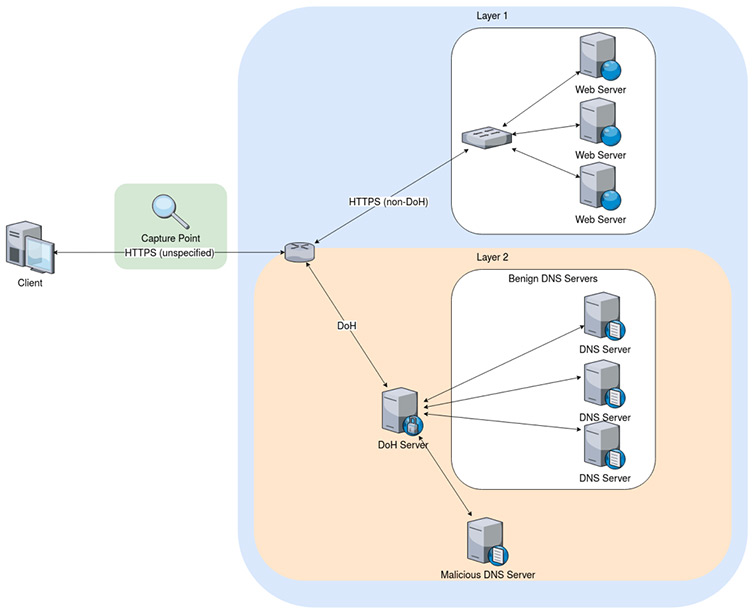Cybersecurity Datasets:
12. Security of DNS over HTTPS (DoH) CIRA-CIC-DoHBrw-2020)
A collaborative project funded by Canadian Internet Registration Authority (CIRA)
Domain Name System (DNS) is one of the early and vulnerable network protocols which has several security loopholes that have been exploited repeatedly over the years. DNS abuse has always been an area of great concern for cybersecurity researchers. However, providing security and privacy to DNS requests and responses is still a challenging task as attackers use sophisticated attack methodologies to steal data on the fly.
To overcome some of the DNS vulnerabilities related to privacy and data manipulation, IETF introduced DNS over HTTPS (DoH) in RFC8484, a protocol that enhances privacy and combats eavesdropping and man-in-the-middle attacks by encrypting DNS queries and sending them in a covert channel/tunnel so that data is not hampered on the way. Nonetheless, unavailability of a representative dataset is the key obstacle to evaluate the techniques that capture DoH traffic in a network topology.
This research work proposes a systematic approach to generate a typical dataset to analyze, test, and evaluate DoH traffic in covert channels and tunnels. The main objective of this project is to deploy DoH within an application and capture benign as well as malicious DoH traffic as a two-layered approach to detect and characterize DoH traffic using time-series classifier.
The final dataset includes implementing DoH protocol within an application using five different browsers and tools and four servers to capture Benign-DoH, Malicious-DoH and non-DoH traffic. Layer 1 of the proposed two-layered approach is used to classify DoH traffic from non-DoH traffic and layer 2 is used to characterize Benign-Doh from Malicious-DoH traffic. The browsers and tools used to capture traffic include Google Chrome, Mozilla Firefox, dns2tcp, DNSCat2, and Iodine while the servers used to respond to DoH requests are AdGuard, Cloudflare, Google DNS, and Quad9.
In CIRA-CIC-DoHBrw-2020 dataset, a two-layered approach is used to capture benign and malicious DoH traffic along with non-DoH traffic. To generate the representative dataset, HTTPS (benign DoH and non-DoH) and DoH traffic is generated by accessing top 10k Alexa websites, and using browsers and DNS tunneling tools that support DoH protocol respectively. At the first layer, the captured traffic is classified as DoH and non-DoH by using statistical features classifier. At the second layer, DoH traffic is characterized as benign DoH and malicious DoH by using time-series classifier.
Non-DoH: Traffic generated by accessing a website that uses HTTPS protocol is captured and labeled as non-DoH traffic. In order to capture ample traffic to balance the dataset, thousands of websites from Alexa domain are browsed.
Benign-DoH: Benign DoH is non-malicious DoH traffic generated using the same technique as mentioned in non-DoH by using Mozilla Firefox and Google Chrome web browsers.
Malicious-DoH: DNS tunneling tools such as dns2tcp, DNSCat2, and Iodine are used to generate malicious DoH traffic. These tools can send TCP traffic encapsulated in DNS queries. In other words, these tools create tunnels of encrypted data. Therefore, DNS queries are sent using TLS-encrypted HTTPS requests to special DoH servers.
A notion of packet clumps is used to reduce the dimensionality of data and remove insignificant packets such as acknowledgements and packets too small to carry data. A clump of packets is defined as a sequence of one or more consecutive packets of a network flow (having the same source and destination) in the same direction to create a new and succinct representation of our data. The rationale for this step is to combine these packets to find the application traffic scattered between several packets in the process of TLS segmentation and IP fragmentation. A threshold timeout value for clumps is also considered so that two packets with a greater time difference do not end up in the same packet clump.
It is imperative to mention that malicious traffic can be tunneling as well as non-tunneling but only tunneled malicious traffic is generated for this research.
The network diagram used to capture the traffic for the dataset is presented in Figure 1. Firstly, normal web browsing activity that includes non-DoH HTTPS and benign DoH is simulated using web browsers. Secondly, malicious DoH is generated by a combination of tools used to create DoH tunnels. Traffic generated by all these tools is captured for pre-processing and training the classifiers.
 Figure 1: Network topology used to capture
Figure 1: Network topology used to capture
As clearly seen from Figure 1, we set up web servers to capture layer 1 data, and benign DNS servers, malicious DNS server and DoH server to capture data at layer 2. The web browsers were configured to use various public DoH resolvers. To connect to Firefox, we also used GeckoDriver which is an intermediary between Firefox and tools that interacts with Firefox. Similarly, for Google Chrome, we used chrome driver to communicate with the browser. Traffic is captured between the DoH proxy and DoH server using tcpdump.
We developed DoHLyzer, a DoH traffic flow generator and analyzer for anomaly and attack detection and characterization. DoHLyzer is a script written in python that uses Scapy to read pcap files or sniff packets online.
A tool named DoH Data Collector is developed to simulate different DoH tunneling scenarios and capture the resulting HTTPS traffic. In each instance of simulation, a new DoH tunnel is made over the underlying network according to different parameters used in a scenario such as:
To generate enough data, the clients used in the simulation were run simultaneously on 10 servers, all connecting to a single C2 server posing as a DNS nameserver. A central controller based on another server controls the timing of simulations. Table 1 lists the IP addresses used to generate non-DoH, benign DoH and malicious DoH traffic at both layers of the project methodology.
DoH Server: Adguard, Cloudflare, Google, Quad9
DNS Tunneling Tool: Iodine, DNS2TCP, DNScat2
Tunneling Client and Server Configurations: Settings such as the delay between sending requests and DNS record types used.
Transmission Rate: Random value between 100 B/s to 1100 B/s
Duration
Table 1: IP addresses used to generate traffic
Destination IPs used for accessing public DoH servers (all TLS packets to these hosts are DoH packets): 1.1.1.1, 8.8.4.4, 8.8.8.8, 9.9.9.9, 9.9.9.10, 9.9.9.11, 176.103.130.131, 176.103.130.130, 149.112.112.10, 149.112.112.112, 104.16.248.249, 104.16.249.249
Source IP used to connect to websites (Google Chrome):192.168.20.191
Source IPs used to connect to websites (Mozilla Firefox):192.168.20.111, 192.168.20.112, 192.168.20.113
Source IPs used to create DoH tunnels:192.168.20.144, 192.168.20.204, 192.168.20.205, 192.168.20.206, 192.168.20.207, 192.168.20.208, 192.168.20.209, 192.168.20.210, 192.168.20.211, 192.168.20.212
Based on the defined scenario in previous section, we implemented the infrastructure and captured the traffic. Table 2 presents the details of packets and flows captured by using browsers/tools and DoH servers.
Table 2: Dataset details
Browser/tool - DoH Server- Packets - Flows - Type
Google Chrome - AdGuard - 5609K - 105141 - HTTPS (Non-DoH and Benign DoH)
Google Chrome - Cloudflare - 6117K - 132552 - HTTPS (Non-DoH and Benign DoH)
Google Chrome - Google DNS - 5878K - 108680 - HTTPS (Non-DoH and Benign DoH)
Google Chrome - Quad9 - 10737K - 199090 - HTTPS (Non-DoH and Benign DoH)
Mozilla Firefox - AdGuard - 4943K - 50485 - HTTPS (Non-DoH and Benign DoH)
Mozilla Firefox - Cloudflare - 4299K - 90260 - HTTPS (Non-DoH and Benign DoH)
Mozilla Firefox - Google DNS - 6413K - 138422 - HTTPS (Non-DoH and Benign DoH)
Mozilla Firefox - Quad9 - 4956K - 92670 - HTTPS (Non-DoH and Benign DoH)
dns2tcp - AdGuard - 1281K - 5459 - Malicious DoH
dns2tcp - Cloudflare - 3694K - 6045 - Malicious DoH
dns2tcp - Google DNS - 28711K - 17423 - Malicious DoH
dns2tcp - Quad9 - 8750K - 138588 - Malicious DoH
dns2tcp - AdGuard - 1301K - 5369 - Malicious DoH
dns2tcp - Cloudflare - 12346K - 9230 - Malicious DoH
dns2tcp - Google DNS - 48069K - 11915 - Malicious DoH
dns2tcp - Quad9 - 9309K - 9108 - Malicious DoH
dns2tcp - AdGuard - 3938K - 11336 - Malicious DoH
dns2tcp - Cloudflare - 5932K - 14110 - Malicious DoH
dns2tcp - Google DNS - 73459K - 12192 - Malicious DoH
dns2tcp - Quad9 - 22668K - 8975 - Malicious DoH
DoHMeter is a tool developed in Python to extract statistical and time-series features from the captured PCAP files. It produces a CSV file as output. The data in that file is labeled flow-wise based on the IP addresses of the servers used in the network diagram (Figure 1). Table 3 lists the 28 statistical features extracted from captured traffic.
Table 3: List of extracted statistical traffic features
Parameter - Feature
F1 - Number of flow bytes sent
F2 - Rate of flow bytes sent
F3 - Number of flow bytes received
F4 - Rate of flow bytes received
F5 - Mean Packet Length
F6 - Median Packet Length
F7 - Mode Packet Length
F8 - Variance of Packet Length
F9 - Standard Deviation of Packet Length
F10 - Coefficient of Variation of Packet Length
F11 - Skew from median Packet Length
F12 - Skew from mode Packet Length
F13 - Mean Packet Time
F14 - Median Packet Time
F15 - Mode Packet Time
F16 - Variance of Packet Time
F17 - Standard Deviation of Packet Time
F18 - Coefficient of Variation of Packet Time
F19 - Skew from median Packet Time
F20 - Skew from mode Packet Time
F21 - Mean Request/response time difference
F22 - Median Request/response time difference
F23 - Mode Request/response time difference
F24 - Variance of Request/response time difference
F25 - Standard Deviation of Request/response time difference
F26 - Coefficient of Variation of Request/response time difference
F27 - Skew from median Request/response time difference
F28 - Skew from mode Request/response time difference
If you want to use the AI techniques to analyze, you can download our generated data (CSV) file and analyze the network traffic. If you want to use a new feature extractor, you can use the raw captured files (PCAP) to extract your features. And then, you can use the data mining techniques for analyzing the generated data.
You may redistribute, republish, and mirror the CIRA-CIC-DoHBrw-2020 dataset in any form. However, any use or redistribution of the data must include a citation to DoHMeter and the following research paper outlining the details of captured DoH traffic:
- Mohammadreza MontazeriShatoori, Logan Davidson, Gurdip Kaur, and Arash Habibi Lashkari, “Detection of DoH Tunnels using Time-series Classification of Encrypted Traffic”, The 5th IEEE Cyber Science and Technology Congress, Calgary, Canada, August 2020
You can download this dataset from here.
To overcome some of the DNS vulnerabilities related to privacy and data manipulation, IETF introduced DNS over HTTPS (DoH) in RFC8484, a protocol that enhances privacy and combats eavesdropping and man-in-the-middle attacks by encrypting DNS queries and sending them in a covert channel/tunnel so that data is not hampered on the way. Nonetheless, unavailability of a representative dataset is the key obstacle to evaluate the techniques that capture DoH traffic in a network topology.
This research work proposes a systematic approach to generate a typical dataset to analyze, test, and evaluate DoH traffic in covert channels and tunnels. The main objective of this project is to deploy DoH within an application and capture benign as well as malicious DoH traffic as a two-layered approach to detect and characterize DoH traffic using time-series classifier.
The final dataset includes implementing DoH protocol within an application using five different browsers and tools and four servers to capture Benign-DoH, Malicious-DoH and non-DoH traffic. Layer 1 of the proposed two-layered approach is used to classify DoH traffic from non-DoH traffic and layer 2 is used to characterize Benign-Doh from Malicious-DoH traffic. The browsers and tools used to capture traffic include Google Chrome, Mozilla Firefox, dns2tcp, DNSCat2, and Iodine while the servers used to respond to DoH requests are AdGuard, Cloudflare, Google DNS, and Quad9.
Introduction
Non-DoH: Traffic generated by accessing a website that uses HTTPS protocol is captured and labeled as non-DoH traffic. In order to capture ample traffic to balance the dataset, thousands of websites from Alexa domain are browsed.
Benign-DoH: Benign DoH is non-malicious DoH traffic generated using the same technique as mentioned in non-DoH by using Mozilla Firefox and Google Chrome web browsers.
Malicious-DoH: DNS tunneling tools such as dns2tcp, DNSCat2, and Iodine are used to generate malicious DoH traffic. These tools can send TCP traffic encapsulated in DNS queries. In other words, these tools create tunnels of encrypted data. Therefore, DNS queries are sent using TLS-encrypted HTTPS requests to special DoH servers.
A notion of packet clumps is used to reduce the dimensionality of data and remove insignificant packets such as acknowledgements and packets too small to carry data. A clump of packets is defined as a sequence of one or more consecutive packets of a network flow (having the same source and destination) in the same direction to create a new and succinct representation of our data. The rationale for this step is to combine these packets to find the application traffic scattered between several packets in the process of TLS segmentation and IP fragmentation. A threshold timeout value for clumps is also considered so that two packets with a greater time difference do not end up in the same packet clump.
It is imperative to mention that malicious traffic can be tunneling as well as non-tunneling but only tunneled malicious traffic is generated for this research.
Infrastructure and implementation

As clearly seen from Figure 1, we set up web servers to capture layer 1 data, and benign DNS servers, malicious DNS server and DoH server to capture data at layer 2. The web browsers were configured to use various public DoH resolvers. To connect to Firefox, we also used GeckoDriver which is an intermediary between Firefox and tools that interacts with Firefox. Similarly, for Google Chrome, we used chrome driver to communicate with the browser. Traffic is captured between the DoH proxy and DoH server using tcpdump.
We developed DoHLyzer, a DoH traffic flow generator and analyzer for anomaly and attack detection and characterization. DoHLyzer is a script written in python that uses Scapy to read pcap files or sniff packets online.
A tool named DoH Data Collector is developed to simulate different DoH tunneling scenarios and capture the resulting HTTPS traffic. In each instance of simulation, a new DoH tunnel is made over the underlying network according to different parameters used in a scenario such as:
To generate enough data, the clients used in the simulation were run simultaneously on 10 servers, all connecting to a single C2 server posing as a DNS nameserver. A central controller based on another server controls the timing of simulations. Table 1 lists the IP addresses used to generate non-DoH, benign DoH and malicious DoH traffic at both layers of the project methodology.
DoH Server: Adguard, Cloudflare, Google, Quad9
DNS Tunneling Tool: Iodine, DNS2TCP, DNScat2
Tunneling Client and Server Configurations: Settings such as the delay between sending requests and DNS record types used.
Transmission Rate: Random value between 100 B/s to 1100 B/s
Duration
Table 1: IP addresses used to generate traffic
Destination IPs used for accessing public DoH servers (all TLS packets to these hosts are DoH packets): 1.1.1.1, 8.8.4.4, 8.8.8.8, 9.9.9.9, 9.9.9.10, 9.9.9.11, 176.103.130.131, 176.103.130.130, 149.112.112.10, 149.112.112.112, 104.16.248.249, 104.16.249.249
Source IP used to connect to websites (Google Chrome):192.168.20.191
Source IPs used to connect to websites (Mozilla Firefox):192.168.20.111, 192.168.20.112, 192.168.20.113
Source IPs used to create DoH tunnels:192.168.20.144, 192.168.20.204, 192.168.20.205, 192.168.20.206, 192.168.20.207, 192.168.20.208, 192.168.20.209, 192.168.20.210, 192.168.20.211, 192.168.20.212
Capturing data and final dataset
Table 2: Dataset details
Browser/tool - DoH Server- Packets - Flows - Type
Google Chrome - AdGuard - 5609K - 105141 - HTTPS (Non-DoH and Benign DoH)
Google Chrome - Cloudflare - 6117K - 132552 - HTTPS (Non-DoH and Benign DoH)
Google Chrome - Google DNS - 5878K - 108680 - HTTPS (Non-DoH and Benign DoH)
Google Chrome - Quad9 - 10737K - 199090 - HTTPS (Non-DoH and Benign DoH)
Mozilla Firefox - AdGuard - 4943K - 50485 - HTTPS (Non-DoH and Benign DoH)
Mozilla Firefox - Cloudflare - 4299K - 90260 - HTTPS (Non-DoH and Benign DoH)
Mozilla Firefox - Google DNS - 6413K - 138422 - HTTPS (Non-DoH and Benign DoH)
Mozilla Firefox - Quad9 - 4956K - 92670 - HTTPS (Non-DoH and Benign DoH)
dns2tcp - AdGuard - 1281K - 5459 - Malicious DoH
dns2tcp - Cloudflare - 3694K - 6045 - Malicious DoH
dns2tcp - Google DNS - 28711K - 17423 - Malicious DoH
dns2tcp - Quad9 - 8750K - 138588 - Malicious DoH
dns2tcp - AdGuard - 1301K - 5369 - Malicious DoH
dns2tcp - Cloudflare - 12346K - 9230 - Malicious DoH
dns2tcp - Google DNS - 48069K - 11915 - Malicious DoH
dns2tcp - Quad9 - 9309K - 9108 - Malicious DoH
dns2tcp - AdGuard - 3938K - 11336 - Malicious DoH
dns2tcp - Cloudflare - 5932K - 14110 - Malicious DoH
dns2tcp - Google DNS - 73459K - 12192 - Malicious DoH
dns2tcp - Quad9 - 22668K - 8975 - Malicious DoH
Feature extraction
Table 3: List of extracted statistical traffic features
Parameter - Feature
F1 - Number of flow bytes sent
F2 - Rate of flow bytes sent
F3 - Number of flow bytes received
F4 - Rate of flow bytes received
F5 - Mean Packet Length
F6 - Median Packet Length
F7 - Mode Packet Length
F8 - Variance of Packet Length
F9 - Standard Deviation of Packet Length
F10 - Coefficient of Variation of Packet Length
F11 - Skew from median Packet Length
F12 - Skew from mode Packet Length
F13 - Mean Packet Time
F14 - Median Packet Time
F15 - Mode Packet Time
F16 - Variance of Packet Time
F17 - Standard Deviation of Packet Time
F18 - Coefficient of Variation of Packet Time
F19 - Skew from median Packet Time
F20 - Skew from mode Packet Time
F21 - Mean Request/response time difference
F22 - Median Request/response time difference
F23 - Mode Request/response time difference
F24 - Variance of Request/response time difference
F25 - Standard Deviation of Request/response time difference
F26 - Coefficient of Variation of Request/response time difference
F27 - Skew from median Request/response time difference
F28 - Skew from mode Request/response time difference
Using the dataset
License
- Mohammadreza MontazeriShatoori, Logan Davidson, Gurdip Kaur, and Arash Habibi Lashkari, “Detection of DoH Tunnels using Time-series Classification of Encrypted Traffic”, The 5th IEEE Cyber Science and Technology Congress, Calgary, Canada, August 2020
You can download this dataset from here.



